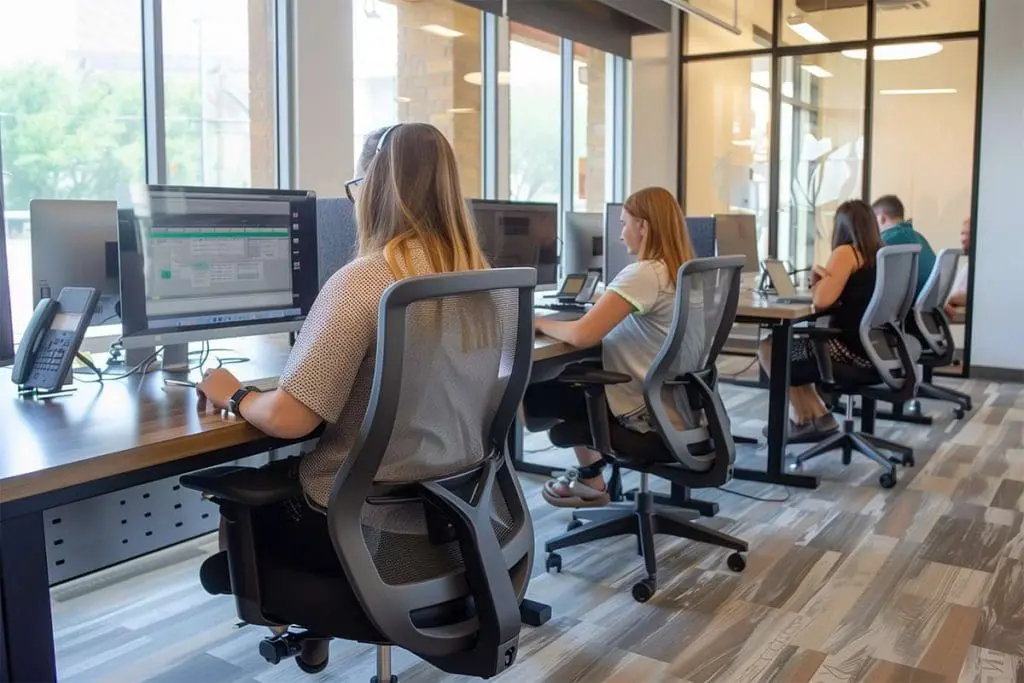Many employers worry about how to attract and retain Gen Z and Millennials, but what about the older workforce?
According to a study by Bain & Company, by 2030 around 150 million jobs will shift to workers over 55, accounting for a quarter of the workforce. Moreover, Pew Research reports that the number of older workers has nearly quadrupled since the mid-1980s.
With fewer young people entering the workforce, an aging population, and the age of retirement trending up (41% of Americans now expect to work beyond 65), employers and HR departments must prepare for the expected impacts.
In this blog, we explore the challenges posed by an aging workforce, best practices for integrating older workers, and more.
Table of Contents
The Economic and Social Drivers

The employment rate among older workers has gradually increased since the mid-1990s. Presently, nearly 20% of adults aged 65 and above are employed. Furthermore, the number of workers aged 75 and above has increased more than four times since 1964, making them the fastest-growing age group in the workforce.
Factors that have contributed to this aging workforce include:
- Higher education levels: According to U.S. Bureau of Labor statistics, older Americans today have higher levels of education, which increases their likelihood of finding employment compared to previous years.
- Healthier populations: Older individuals have improved health and lower disability rates than before, enabling more of them to continue working. In addition, working later in life can have positive effects on health and well-being.
- Lower fertility rates: Declining fertility rates have resulted in a labor supply shortage. According to a 2022 U.S. Census study, fertility rates for women between 20 and 24 have decreased by 42% since 1990. This decrease in birth rates has caused a decline in the number of younger individuals entering the workforce. In 2023, only 55% of individuals aged between 16 and 24 were employed, compared to 77.5% in 1989. As a result, there are now more opportunities for older individuals to remain active in the labor market.
- Changing nature of work: In the past, older workers had limited job opportunities due to physical limitations. However, with the advancement of technology and changes in the economy, there are now opportunities that favor cognitive and analytical skills rather than manual labor. As per the National Institutes of Health (NIH), this shift has enabled more Americans to continue working despite age-related health limitations.
- Retirement age is ticking up: In 1983, the government increased the full retirement age, delaying the collection of Social Security benefits until the age of 67 for those born in 1960. This legislation had a significant financial impact on many Americans, spurring many individuals to remain in the workplace longer.
- Retirement plans have evolved: The transition from traditional pension plans that encourage individuals to retire at the age of 65 to the present 401(k) plans that benefit higher-income workers has resulted in Americans working for longer periods. According to statistics, only 10% of individuals between the ages of 62 and 70 are financially secure and retired. Most of them continue to work either because they enjoy their jobs or because they cannot afford to retire.
Challenges Posed by an Aging Workforce
An aging workforce presents a wide variety of challenges for employers and HR leaders:
- Physical challenges: Older workers in physically demanding jobs may face health and safety challenges. According to the Economic Policy Institute, 50% of older workers have physically demanding jobs, and 54% are exposed to unhealthy or hazardous conditions. These age-related risks can also have business impacts, including lost productivity, increased workers’ compensation claims, and absenteeism.
- Negative stereotypes: Hiring managers and colleagues may perceive older workers as old-fashioned, less flexible, unhealthy, slow, unproductive, and resistant to change. Studies prove these stereotypes can negatively impact older workers’ identification with the company, feelings of belonging, self-esteem, access to developmental opportunities, and career satisfaction.
- Higher absenteeism: Surprisingly, working Americans aged 55 years and older are much less likely than younger workers to be seriously injured enough to lose work time. But when they are injured, older workers typically require two weeks to recover before returning to work, twice the recuperation time younger workers need.
- Retirement risk: As the workforce ages, a time will come when older employees want to retire, leading to talent gaps that employers must fill. However, asking employees to delay retirement may not be practical. In such cases, employers should consider developing strategies to retain their top talent, regardless of their age. To support older workers, companies can offer flexible hours, hire retired workers as independent contractors, or provide phased retirement programs that allow older employees to transition from full-time to part-time jobs.
- Knowledge loss: Aging workers have acquired decades of skills and experience. Even if they delay their retirement, employers must prepare for the inevitable and implement succession plans, such as mentor-protégé programs where older workers train younger ones. These programs can not only help transfer knowledge to the younger workers but also provide an opportunity for them to learn from the experience of their seasoned counterparts.
Best Practices for Integrating Older Workers
Many employers implement practices to integrate and support the aging workforce effectively and ensure they remain valuable assets to the organization, but much work remains. A survey by AARP (cited by Bain here) found that fewer than 4% of employers have committed to programs that support a multi-generational workforce, and only 27% said they are “very likely” to explore them.
Below are some best practices for integrating older employees that can help close this gap and create high-quality jobs for an aging workforce.
Developing Age-Friendly Work Environments

A workplace that accommodates the needs of older employees is crucial for driving employee engagement and improving self-esteem, ensuring a healthy and safe workplace, boosting productivity, and ensuring business success.
One of the most important priorities for employers is to provide flexible working conditions for older employees. According to AARP, flexibility in terms of working hours, location, and job-protected time off is highly valued by older workers and is a significant factor in their job satisfaction. Flexible working conditions can encourage older employees to stay in the workforce longer and assist those with health conditions.
Other accommodations for older workers include ensuring an ergonomic workplace. An ergonomic workplace can reduce employee injuries, minimize absenteeism, limit worker’s compensation claims, and ensure a productive workforce. Check out these workplace ergonomics best practices from the Occupational Safety and Health Administration (OSHA).
Functional Capacity Wellness Programs
A functional capacity wellness program can help evaluate and ensure workers are physically fit for their roles and are able to perform workplace tasks safely and without injury. Employers also benefit from a decrease in lost workdays and lower insurance costs.
Functional capacity wellness programs can comprise pre-employment, fit-for-duty, and return-to-work medical exams, medical surveillance, and wellness education and resources. In addition to assessing employees for medical conditions, these programs also assess physical capabilities, such as the ability to operate heavy machinery or lift heavy equipment.
Retraining and Skill Development

Continuous education and retraining programs tailored to older workers, specifically those focused on technology and digital tools, can help empower older workers with vital skills and growth opportunities. Below are relevant training programs that can help older workers stay relevant in the job market and participate in ongoing learning opportunities.
Emphasizing Tech Skill Acquisition
According to Bain, 22% of workers aged 55 to 64 need more tech skills. Yet only half of older workers (55%) report completing job training of any type in the past five years.
Reskilling and engaging older workers can ensure that companies have the necessary skills required to stay ahead of technological innovation. To achieve this, managers and supervisors should encourage participation in technology training across all age groups and not just focus on younger employees.
Creating Lifelong Learning Opportunities
Older workers possess distinct learning styles and motivations that set them apart from younger generations. As the job-seeking population continues to diversify with age, HR leaders must implement a workforce development system that caters to their ongoing training and retraining needs. This system should focus on providing skills that align with the high-growth positions in the job market, while also addressing older workers’ desire for engaging work and competitive pay.
To boost employee engagement, employers should evaluate the skills and experience of their older workers and create customized training programs to meet their specific requirements. Because experienced employees may not always find training exciting or necessary, offering incentives and rewards can be an effective way to motivate them. Furthermore, senior staff members can take charge of training sessions or mentor their younger colleagues, which can enhance teamwork and earn them the respect of their peers.
Policy and Organizational Changes for a Multigenerational Workforce
To create a more inclusive workplace that integrates older workers, it is important to implement policy and organizational changes that address their unique challenges. This can include initiatives such as flexible work arrangements, training and development programs that cater to older workers, and strategies to combat age discrimination.
By taking these steps, organizations can effectively leverage the experience and expertise of older workers while also promoting diversity and inclusivity in the workplace. Consider the following:
Adjusting HR Policies
Implementing HR policies that cater to age diversity is crucial in creating a workplace that is inclusive to employees of all ages.
To foster an inclusive environment for older workers, companies should develop and implement:
- Practices that prevent age discrimination.
- Retirement options that are flexible and accommodating to employees at different stages of their careers.
- Health benefits that are tailored to the needs of older employees.
Fostering an Inclusive Culture
A study conducted by AARP revealed that 71% of older workers report higher levels of job satisfaction when their workplace respects and appreciates diverse perspectives and opinions and fosters an environment conducive to growth and development for all.
Indeed, evolving workplace demographics offer businesses an opportunity to harness the benefits of a multigenerational workforce, leveraging the unique skills and experiences of employees across different age groups.
Effective strategies include mentorship programs and promoting roles that leverage the experience of seasoned workers. For example, they may be ideal candidates for leadership or advisory positions that require a high degree of specialized knowledge.
Furthermore, employers should consider providing older employees with engaging and stimulating work. While good compensation is a key motivator for workers below the age of 60, older workers prioritize interesting work as the top attribute. To attract and retain older employees, it’s important for employers to understand the workplace characteristics that they seek and what motivates them.
By recognizing and capitalizing on the strengths of older workers, organizations can create a more diverse and inclusive workplace that benefits everyone involved.
Conclusion: Future Outlook and Strategic Recommendations
The role of older workers in the workplace will continue to grow over the next decade. According to projections from the U.S. Bureau of Labor, adults over 65 will represent more than 8% of the workforce, accounting for 57% of labor force growth.
To remain competitive and inclusive, employers must adapt their business strategies to accommodate an aging workforce and leverage this demographic’s skills and experience. Best practices include flexible working conditions, workplace health and wellness programs, career development opportunities, and HR policies that support age diversity.
Acuity Can Help
At Acuity, we offer a range of employee health programs designed to help you integrate older employees into the workplace, including medical exams, physicals, wellness assessments, and more – all tailored to the unique needs and risks of your organization and employee population. Our services include:
- Wellness and prevention programs
- Workplace physical exams and medical screening
- Mobile and on-site health events
- Mental health case management and behavioral health services (covering mental health screening, advocacy, education, non-medical counseling, treatment plans, etc.)
- And more.
Learn more about our comprehensive occupational health services or contact us today.
